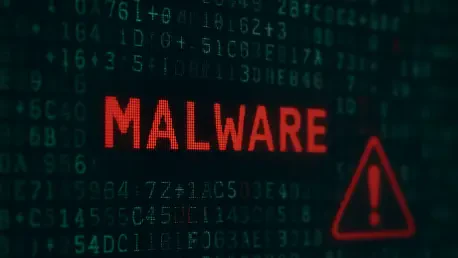The Rising Threat of Ransomware: A New Era of Extortion
Imagine a scenario where a company’s digital infrastructure is held hostage, but the demands go beyond mere financial payment—threats of physical harm to executives and their families accompany the ransom note, instilling a chilling fear that transcends the virtual realm. This disturbing reality marks the current state of the ransomware landscape, a domain of cybersecurity that has grown into one of the most significant threats to organizations worldwide. Over the past few years, ransomware attacks have surged in frequency and sophistication, targeting businesses, governments, and critical infrastructure with devastating consequences.
No longer confined to locking systems or encrypting data, ransomware gangs have shifted toward more aggressive and personal tactics. The emergence of physical violence as a coercion method signals a grim evolution, where attackers exploit not just technological vulnerabilities but also human fears. This trend is underscored by groups like ALPHV, notorious for their ruthless strategies, pushing the boundaries of extortion beyond the digital sphere.
Surveys, such as one conducted by Censuswide for Semperis involving 1,500 security and IT professionals, reveal the alarming scope of this issue. The findings highlight a pervasive threat environment where organizations face not only technical challenges but also psychological warfare. This report delves into these evolving dangers, exploring how ransomware has transformed into a multifaceted menace that demands urgent attention and innovative defenses.
Evolving Tactics of Ransomware Gangs
Diversification of Coercion Methods
Ransomware gangs have expanded their arsenal of intimidation tactics, moving far beyond traditional methods of system lockouts and data encryption. According to survey data, 52% of respondents reported experiencing system lockouts, while 63% faced data destruction as a primary threat. However, newer, more insidious strategies have emerged, with 47% of professionals noting threats of regulatory complaints and a staggering 40% encountering warnings of physical violence.
Specific incidents paint a stark picture of this shift. For instance, ALPHV, a prominent ransomware group, filed an SEC complaint against MeridianLink for failing to disclose a security breach, weaponizing regulatory frameworks to pressure victims. Even more personal are the threats of physical harm, often directed at executives’ families, leveraging detailed personal information such as home addresses or children’s school locations to heighten fear.
These threats are frequently vague, a deliberate tactic to maximize psychological impact. By avoiding specifics about when or where an attack might occur, attackers keep victims in a constant state of anxiety, amplifying the pressure to comply with ransom demands. This blend of digital and personal intimidation marks a dangerous new chapter in cybercrime.
Statistical Insights and Impact on Organizations
Despite a slight decline in the overall number of organizations affected by ransomware—down to 78% from a previous 83%—the severity of successful attacks remains undiminished. Data indicates that 56% of these incidents result in infections, showcasing the persistent challenge of defending against sophisticated malware. The impact is not fleeting but deeply disruptive, affecting operations and trust.
Multiple attacks compound the problem, with 73% of victims experiencing repeated incidents and 31% enduring three or more assaults. Recovery times have also worsened, with only 23% of organizations restoring operations within a day, a significant drop from 39% previously. Meanwhile, 18% require between one week and a month to recover, up from 11%, reflecting the growing complexity of rebuilding compromised systems.
Experts like Jeff Wichman, a seasoned professional in breach preparedness, point to the extensive damage caused by attackers as a key factor. Compromised environments often suffer irreparable harm, necessitating full rebuilds from backups. This trend suggests that the operational and financial toll of ransomware will continue to escalate, demanding more robust contingency planning.
Challenges in Combating Ransomware Threats
The fight against ransomware presents multifaceted challenges that extend beyond technical defenses. Organizations grapple with the psychological burden of physical threats, which target not just data but the personal safety of employees and their loved ones. This added layer of fear complicates decision-making, as leaders must balance operational recovery with human security concerns.
Paying ransoms, often seen as a quick resolution, proves unreliable and risky. Statistics show that 15% of those who pay fail to receive usable decryption keys, while 3% still face data leaks despite compliance. Furthermore, attackers frequently retain stolen data for resale, undermining any promises of confidentiality and perpetuating the cycle of exploitation.
Mitigation strategies must evolve to address these realities. Refusing to pay ransoms, though difficult, is advocated by many experts as a way to deter future attacks. Simultaneously, investments in comprehensive cybersecurity defenses and employee protection measures are critical. Organizations need to prioritize training, incident response plans, and safeguards that protect both digital assets and personal well-being.
Regulatory and Ethical Considerations in Ransomware Response
Navigating the regulatory landscape adds another layer of complexity to ransomware responses. Gangs exploit compliance requirements by filing complaints against victims for failing to disclose breaches, as seen in certain high-profile cases. This tactic not only pressures organizations financially but also damages their reputation and legal standing.
Ethically, the decision to pay ransoms poses a significant dilemma. While capitulation might seem to avert immediate harm, it often emboldens attackers to strike again, as noted by experts like Jeff Wichman who strongly advise against it. The consensus leans toward building resilience rather than yielding, emphasizing the importance of preparedness over reaction.
Compliance with data protection laws remains non-negotiable, requiring organizations to implement stringent security measures. Beyond protecting data, there is a pressing need to safeguard personnel from personal threats. Balancing regulatory obligations with ethical stances demands a proactive approach, integrating legal counsel and security protocols to address this dual challenge.
The Future of Ransomware: A Darkening Horizon
Looking ahead, the trajectory of ransomware threats appears increasingly ominous, with physical intimidation expected to become more prevalent over the next 12 months. Former negotiator Jeff Wichman warns of an escalation in such tactics, predicting that attackers will refine their methods to exploit personal vulnerabilities with greater precision, further blurring the line between digital and real-world harm.
Emerging disruptors in this space include more sophisticated attack vectors that combine technological innovation with psychological coercion. The integration of detailed personal data into threats suggests a future where intimidation becomes even more targeted. This evolution necessitates a rethinking of defense strategies to counter both cyber and physical risks.
Growth areas for cybersecurity include advanced prevention technologies, enhanced employee safety protocols, and international collaboration to dismantle ransomware networks. Innovation must focus on predictive analytics to anticipate attacks and on fostering global partnerships to disrupt the financial incentives driving these crimes. A united front is essential to curb the expanding reach of these threats.
Conclusion: Preparing for an Uncertain Future
Reflecting on the insights gathered, the ransomware landscape reveals a menacing evolution from digital disruptions to personal threats of physical violence. The persistent nature of these attacks, coupled with prolonged recovery times and unreliable ransom outcomes, underscores the severity faced by organizations across industries.
Moving forward, actionable steps emerge as a critical focus. Organizations are urged to bolster cybersecurity frameworks with cutting-edge technologies and to adopt a firm stance against paying ransoms, thereby reducing the profitability of such crimes. Implementing comprehensive training and safety measures for personnel also stands out as a vital strategy to mitigate personal risks.
Lastly, global cooperation surfaces as a cornerstone for future progress. By fostering alliances among governments, businesses, and security experts, the collective effort aims to dismantle ransomware ecosystems. This united approach, paired with innovative defenses, promises a stronger shield against the multifaceted threats that have reshaped the cybersecurity domain.









